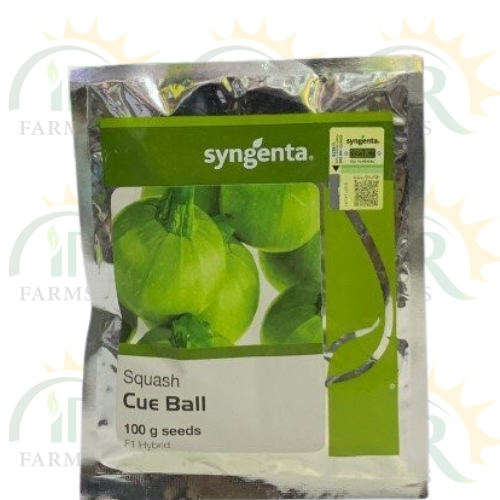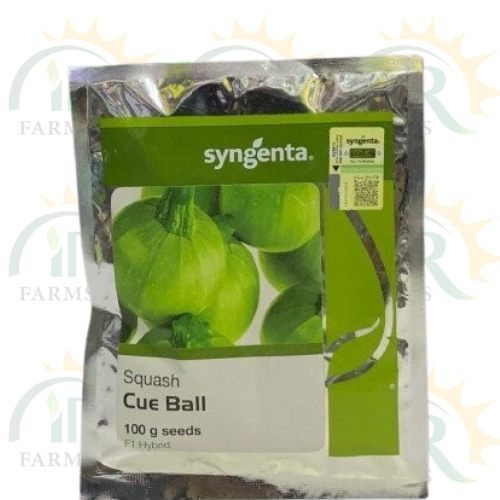Squash Cue Ball F1 Hybrid Seeds (100 gm) Syngenta Seeds
Squash Cue Ball F1 Hybrid Seeds (100 gm) Syngenta Seeds
Available in stock (85)
Squash Cue Ball F1 Hybrid Seeds
Squash Cue Ball F1 Hybrid Seeds are the perfect choice for anyone looking to grow delicious squash in their garden. Available in a handy 100 gm pack, these seeds are designed for strong growth and impressive yields. These F1 hybrid seeds will help you cultivate healthy, high-quality squash that stands out for its flavor and appearance.
What sets these seeds apart is their adaptability; they thrive in various conditions, making them ideal for different climates. Plus, you can expect uniform, attractive fruits that not only look great but taste amazing.
Key Features
Feature |
Description |
|
F1 Hybrid Quality |
Delivers consistent, high-yield squash production for superior results. |
|
Pack Size |
100GM, suitable for small and large-scale planting needs. |
|
Robust Growth |
Strong plants that adapt well to various growing conditions, ensuring resilience. |
|
Uniform Fruits |
Produces attractive, uniformly shaped squash with exceptional flavor and texture. |
|
Trusted Brand |
Developed by Syngenta Pakistan Limited, a leader in agricultural innovation and quality. |
Benefits Of F1 Hybrid Seeds
F1 hybrid seeds, are specially bred to combine the best traits of parent plants. Here are some key benefits:
1. Higher Yields
F1 hybrids typically exhibit greater productivity compared to traditional varieties. The Squash Cue Ball seeds are optimized to deliver a significant yield per plant, making them ideal for growers seeking efficiency.
2. Disease Resistance
These seeds are developed to enhance resilience against common diseases, which reduces the need for chemical interventions and helps ensure healthier crops.
3. Uniform Growth
F1 hybrids tend to produce fruits that are more uniform in size and shape, which is particularly advantageous for market growers aiming for consistency and quality in their produce.
4. Enhanced Flavor and Texture
The breeding processes behind F1 hybrids often focus on improving taste and culinary qualities, leading to squash that is not only appealing but also delicious.
5. Adaptability
The Squash Cue Ball F1 hybrid seeds are designed to thrive in various environmental conditions, providing flexibility for growers across different regions.
Growing Instructions
Soil Preparation
-
Select a Well-Drained Site: Choose a location that receives full sun for optimal growth.
-
Soil Testing: Test the soil pH; squash prefers a pH range of 6.0 to 6.8.
-
Amend the Soil: Incorporate organic matter such as compost or well-rotted manure to enhance soil fertility and drainage.
Sowing Seeds
-
When to Plant: Sow seeds after the last frost date when the soil temperature reaches at least 65°F (18°C).
-
Spacing: Plant seeds 1 inch deep, with a spacing of 24-36 inches between plants to allow ample room for growth.
Watering
-
Maintain consistent moisture during germination. Water deeply but infrequently to encourage deep root growth.
Fertilization
-
Use a balanced fertilizer high in phosphorus to promote flowering and fruiting. Follow the application rates recommended on the product label.
Pest and Disease Management
-
Monitor for common pests like squash bugs and cucumber beetles. Implement integrated pest management strategies as needed.
Frequently Asked Questions
What makes F1 hybrid seeds different from regular seeds?
F1 hybrid seeds are produced from a controlled cross of two different parent plants, resulting in offspring with desirable traits. They typically offer higher yields, disease resistance, and uniformity compared to traditional open-pollinated seeds.
What is the best time to plant squash in my area?
The best planting time depends on your local climate. Generally, squash should be planted after the last frost date in your region, when soil temperatures are consistently warm.
What are the ideal growing conditions for Squash Cue Ball F1 hybrid seeds?
These seeds thrive in well-drained soil with good organic content and require full sunlight (at least 6-8 hours a day). They prefer a temperature range of 70°F to 85°F (21°C to 29°C).
Are there any specific pest management strategies for squash?
Regular monitoring for pests, using row covers, and introducing beneficial insects are effective strategies. Additionally, crop rotation can help minimize pest problems.
Couldn't load pickup availability
Don’t miss out on this limited-time advantage crafted for you
About This Product
About This Product
Our agriculture products are selected to help farmers grow healthy crops and achieve better yields. Every product is genuine, effective, and trusted in the farming community.
Why Choose This Product?
- 🌱 Improves crop growth and protection
- 💧 Easy to apply with clear instructions
- 🛡️ Safe and reliable for farm use
- 📦 Delivered fresh with secure packaging
We aim to provide farmers with the right solutions for every season.
Product Highlights
Product Highlights
- Genuine and trusted by farmers
- Supports crop health and yield
- Easy to apply with clear guidance
- Suitable for major crops in Pakistan
- Safe and effective for long-term use
Shipping & Return
Shipping & Return
We deliver all across Pakistan, aiming for same-day delivery whenever possible. Most orders reach you within 2–4 working days, packed with care. If you receive a damaged or wrong product, you can request a return or exchange within 7 days — quick, simple, and hassle-free.
Your payment information is processed securely. We do not store credit card details nor have access to your credit card information.
4 Steps to a Healthier Farm

Prepare & Protect
Give your crops the strong foundation they need. Healthy soil and proper preparation ensure that seeds, fertilizers, and crop protection products work effectively to support growth and resist pests.

Nourish & Boost
Provide essential nutrients and supplements to your crops. Using the right fertilizers and growth enhancers helps plants develop strong roots, vibrant leaves, and better overall health.

Monitor & Care
Regularly check on your plants to prevent diseases, pests, or nutrient deficiencies. Timely observation and care help maintain crop quality and maximize yields.

Harvest & Celebrate
Reap the benefits of your hard work! Healthy, thriving crops lead to higher yields, better profits, and the satisfaction of seeing your farm flourish.
Discover more in our FAQ
Are your products original?
Are your products original?
Yes, all our products are 100% genuine. We source seeds, fertilizers, and pesticides directly from trusted companies to make sure farmers always get reliable quality.
How many days does delivery take?
How many days does delivery take?
Normally delivery takes 2–4 working days anywhere in Pakistan. We ship through Leopard and TCS, so even remote areas are covered quickly.
Do you offer Cash on Delivery?
Do you offer Cash on Delivery?
Yes, Cash on Delivery is available all over Pakistan. You can check your parcel before paying to stay worry-free.
What if I get a wrong or damaged product?
What if I get a wrong or damaged product?
No problem at all. If you receive the wrong or damaged item, just contact our support team. We will arrange a quick replacement or refund without hassle.




